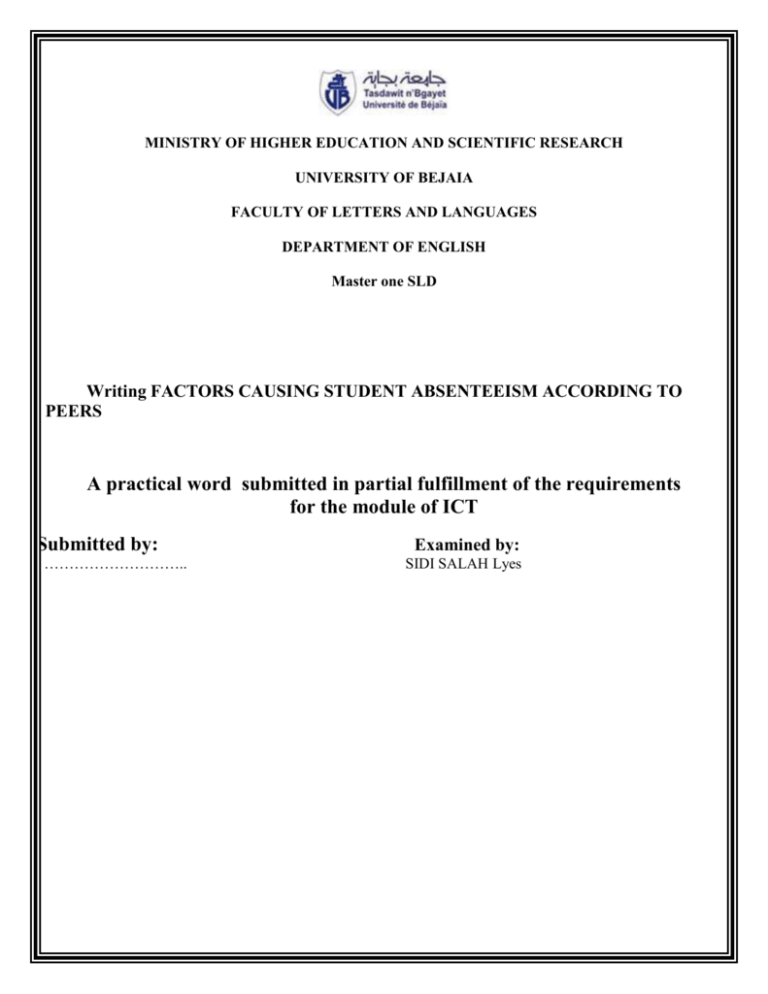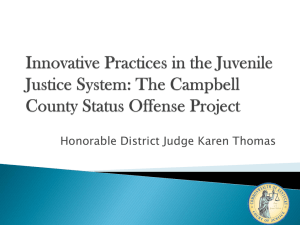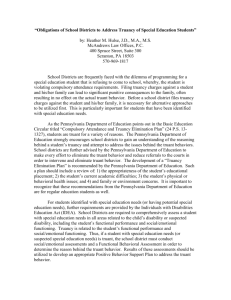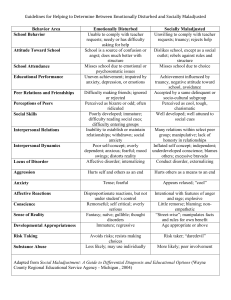Electronic Media Factor - E
advertisement

MINISTRY OF HIGHER EDUCATION AND SCIENTIFIC RESEARCH UNIVERSITY OF BEJAIA FACULTY OF LETTERS AND LANGUAGES DEPARTMENT OF ENGLISH Master one SLD Writing FACTORS CAUSING STUDENT ABSENTEEISM ACCORDING TO PEERS A practical word submitted in partial fulfillment of the requirements for the module of ICT Submitted by: ……………………….. Examined by: SIDI SALAH Lyes Abstract There are many factors involved in motivating students to attend school. Students who are not motivated, hence, will usually decide not to be present in school. Based on several researches conducted, the rate of absenteeism among students increases annually. As a result, this problem will more or less adversely affect the school’s reputation. Thus, this study is conducted to identify factors that cause students to play truant. A set of questionnaire was used to collect the information needed. The quantitative data was analyzed using Statistics Package for the Social Sciences (SPSS) to obtain descriptive statistics indices. The research findings were duly discussed. Key words: Motivation, Truancy, School’s reputation. INTRODUCTION Indiscipline among students is a perennial problem. One common discipline problem found globally is truancy. Davies and Lee (2006) found that school children in the United Kingdom are inclined not to go to school or choose not to attend certain classes during the school hours. Truancy also occurs among Malaysian students, and according to Ee Ah Meng (2003), it has become a social moral issue. Indeed, what is of concern is that the spread of the truancy problem has given rise to various moral and social problems among students. This cannot be treated lightly, because in Malaysia it has been reported that truancy nearly tops the list of acts of misbehavior among students. Indeed, Circular 6/1995 of the Ministry of Education (MOE) Malaysia stated explicitly that truancy was, and stiil is, a behavior that violates school rules. Various papers have reported cases of Malaysian school children involved in truancy. This problem of absenteeism is regardless of gender, race and religion. The act of truancy among students occurs when there is an attitude problem among students towards schooling to seek knowledge. Based on the records of MOE, a total of 24,840 students in 2006 and 21,060 in 2007, were found to have committed truancy. Of the eight types of discipline problems listed by MOE, truancy was then ranked second highest after ‘lack of politeness’. Other discipline problems were actions that are criminal in nature, time wasting, personal neatness, delinquency, vandalism and obscenity. The issue is students who stay away from school without permission will not only be left behind in the learning process, but worse still they will probably end up in drug abuse, gangsterism, alcohol consumption, free sex, gambling and loitering. Certainly, playing truant is a discipline problem, and where do these truants go to and what they do during the time of their absence from school are related concerns. There are many factors why children stay away from school without permission. In Malaysia, these factors include influence of peers (Mohd. Shubari, 2000; Suseladevy, 2004), fear of being bullied, fear of teachers, dislike of certain subjects, thinking that they will fail (Thi, 1994; Supramaniam, 1986), no encouragement from parents or family problems (Mohamad Yatim, 1999), and the school factor (Hussein, 1993; Zainol, 2002; Tan, 2006). All of these factors have resulted in students having no motivation to learn, therefore they turn their attention to hang around at other places or loitering. Research findings have also shown that students who do not support and participate in any school programs or activities are those who are not interested to be in school (She, 2002). This study has attempted to revisit and identify factors contributing to the act of truancy. This study is probably quite unique in Malaysia as it did not focus on students who skip school. Instead, this study explored the perceptions of students regarding the reason their truant friends were not motivated to attend school or why they were absent from certain classes. OBJECTIVE OF THE STUDY In general, the objective of this study is to examine the phenomenon of truancy among secondary school students; however, specifically the objective is to identify the factors that cause students to be absent from classes or schools according to the perceptions of their schoolmates who are their friends. RESEARCH METHODOLOGY Research Design This study is a descriptive case study. According to Majid (1998), the design of a study is related to specific techniques and methods to obtain information needed to solve a problem. The case study used intends to investigate a phenomenon in the natural context and it is more focused on the question of 'why' an event occurs and 'how' it happens (Yin, 1994). In this case, this study seeks to identify the causes or factors that influence truancy among students. Population and Sample The population of this research consists of form four students (aged 16 years) in the Maahad Religious Secondary School. The researchers used the purposive sampling technique to obtain samples representing four such schools in a district in Johor (one of the states in Malaysia). According to Merriam (1998), using 'purposive sampling' enables researchers to understand a phenomenon in depth. Instrument Data were collected through a questionnaire distributed by one of the researchers. The items developed in the questionnaire refer to some related previous studies. The questionnaire comprises two parts, Part A deals with demographic questions, and Part B contains 52 questions related to factors that cause pupils to be absent from school. A five-point Likert scale is used to identify student respondents' level of agreement on a statement given. The scale is as follows: 5.Strongly agree; 4. Agree; 3. Not sure; 2. Disagree; and 1. Strongly disagree. The pilot study shows that the alpha values obtained for the questionnaire used are between 0.795 and 0.945. In addition to the questionnaire, the researcher also obtained information about students who absent themselves from school through the attendance records of students and the Student Discipline Governance System which uses the e-truancy application. Data Analysis The data obtained through the questionnaire were analyzed using the Statistical Package for Social Sciences (SPSS) version 12.0 to get the percentage, frequency, mean, standard deviation and correlation. FINDINGS AND DISCUSSIONS Background of Respondents The respondents were 58 boys (58%) and 42 girls (42%) (Table 1). In terms of ethnicity, 98 of the respondents were Malays, and only two Chinese. A total of 50% of respondents lived in urban areas and the other half lived in rural areas. All the 100 students were the schoolmates and friends of students who were known to have committed truancy. Table 1. Background of Respondents Respondents Frequency Percentage (%) Gender Male Female 58 42 58.0 42.0 Race Malay Chinese Indian Others 98 2 0 0 98.0 2.0 0.0 0.0 Home Location Urban Rural 50 50 50.0 50.0 Total 100 100.0 Factors Influencing Student Truancy The first objective of this study is to identify the factors or the root causes that have led students to become truants. A score range was used to enable the researchers to identify these factors. Factors with scores of 2.04 - 2.71 are factors that have little influence as causes for truancy. While factors with scores of 2.72 - 3.39 are considered as factors that sometimes caused truancy, and factors with scores of 3.40 - 4.07 often influence students to stay away from school without permission. Table 2 below shows the distribution of mean and standard deviation to indicate the factors that influence absenteeism among students in the school studied. The electronic media factor (mean = 3.64, SD = 0:56) is the highest factor. This is followed by the family (mean = 3:01, SD = 1:05), school climate (mean = 2.71, SD = 0. 0.61), student (mean = 2.68, SD = 0.79), peer (mean = 2.64, SD = 0.76) and the teacher factor (mean = 2:54, SD = 0.76). Table 2. Distribution of Mean and Standard Deviation for Factors Affecting Truancy Factors That Affect Truancy Mean SD Electronic media factor 3.64 0.56 Family factor 3.01 1.05 School climate factor 2.71 0.61 Student factor 2.68 0.79 Peer group factor 2.64 0.76 Teacher factor 2.54 0.76 Electronic Media Factor The electronic media factor was found to be the most influential factor related to truancy, with average mean 3.64 (SD = 0.56). The most influential item related to the electronic media factor is "television that broadcasts programs 24 hours a day can eliminate boredom while at home" (mean = 4.31, SD = 0.69). This is consistent with research done by Media Dyamic (1996) which found that a total of seven million young people watched television in Asia. Children spent 28 hours a week watching television. Socio-cultural conditions also influence the way people watch television. The next item that scores the highest mean is "computer games at computer centers can reduce stress while studying" (mean = 4:07, SD = 0.98), followed by "electronic media affect children’s life style pattern" (mean = 3.93, SD = 1.05) and "electronic game is entertaining" (mean = 3.80, SD = 1.10). All these would adversely affect the motivation of students to attend school. Details of items for the electronic media factor are shown in Table 3 below. Table 3. Distribution of Mean Scores and Standard Deviation for Electronic Media Factor No Items Mean SD 1. Electronic game is a waste of time 2.49 1.29 2. Electronic game is entertaining 3.80 1.10 3. Like entertainment more than attending school 3.48 1.38 4. Computer games at computer centers can reduce stress while studying 4.07 .98 5. Entertainment centers are the ideal places for students who are absent from school to meet 3.43 1.32 6. Television program that broadcasts 24 hours a day can eliminate boredom while at home 4.31 0.69 7. Electronic media affect children’s life style pattern 3.93 1.05 Family Factor The second most important factor contributing to truancy among students is the family. The item related to this factor that has the highest mean score is "mother and father often quarrel at home" (mean = 3.19, SD = 1.31). This is consistent with the study carried out by Moore and Hotch (1982) which found that divorced parents is the main reason why adolescents leave home to follow their friends which might have led them to skip school. This is followed by the item "parents are rarely at home because busy at work" (mean = 3.11, SD = 1.33) and "mother and father love other family members more than the student" (mean = 3.04, SD = 1.36). Details of items for the family factor are shown in Table 4 below. Table 4. Distribution of Mean Scores and Standard Deviation For Family Factor No Items Mean SD 1. Parents are rarely at home because busy at work 3.11 1.33 2. Parents hand over their responsibility to caregivers 3.02 1.33 3. Parents often encourage students to learn 2.93 1.49 4. Mother and father often quarrel at home 3.19 1.31 5. Parents care less whether their children go to school or not 2.91 1.53 6. Parents provide all the facilities at home 2.84 1.25 7. Mother and father love other family members more than the student 3.04 1.36 Note: Total Mean For Family Factor : 3.01 (SD = 1.05) School Climate Factor The school climate or environment factor has also influenced students to be absent from school (Table 5). However, the overall mean obtained is 2.71 (SP = 0.61). This indicates that the school environment factor has not much influence on truancy. Related to this factor, items which obtain the highest mean is "number of students in the classroom disrupts the focus on the teaching - learning process" (mean=3.27, SD=1.20). This situation is consistent with the research done by Foziah Ab Rahman (1996) who found that unattractive school climate or environment has made students unhappy and lazy to go to school. Omardin (1996) also points out that one of the factors that determines the success of students is the school climate and culture. A harmonious school environment can lift the spirit of students who would then have the attitude of “love their school”. Hence, this will reduce misconduct among students such as skipping school. Other items related to school environment are “school rules are too strict” (mean = 3.20, SD = 1.34) and “extra classes arranged by the school are a burden to students (mean = 3.00, SD = 1.35). As for items with low scores, they are as follows: “the canteen food is not delicious yet expensive” (mean = 2.36, SD = 1.17), followed by “the relationship between students and teachers in the classroom is good” (mean = 2.48, SD = 1.07) and “the school provides adequate facilities for students” (mean = 2.49, SD = 1.19). Table 5. Distribution of Mean Scores and Standard Deviation for School Climate Factor No Items Mean SD 1. Chairs and tables in the classroom are comfortable 2.66 1.33 2. Number of students in the classroom disrupt the focus on the teachinglearning process 3.27 1.21 3. The relationship between students and teachers in the classroom is good 2.48 1.07 4. The school put pressure on students to pass with flying colors 2.51 1.20 5. The school regularly organizes meetings with parents 2.92 6. Do not like the atmosphere in the classroom 2.51 1.05 7. The school provides adequate places for rest 2.61 1.18 8. Feel comfortable with the school environment 2.54 1.17 9. Extra classes arranged by the school are a burden to students 3.00 1.35 10. School rules are too strict 3.20 1.34 11. The school provides adequate facilities (equipment and materials) for students 2.49 1.19 12. The canteen food is not delicious yet expensive 2.36 1.17 1.12 Note: Total Mean for School Environment Factor: 2.71 (SD = 0.61) Student Factor The findings of this research show that the overall mean obtained for the student factor is 2.68 and SD=0.79 (Table 6). This means that the attitude of students is also not a very strong factor in influencing truancy among students. The item "go to school because forced by parents" scores the highest mean (mean = 3.17, SD = 1:44) and this is consistent with Ismail Haji Din’s (1990) findings which stresses that attitude can be a significant influence on the individual student. It acts as a cause and consequence of a behavior. This item is followed by item "always sleepy and often wake up late for school” (mean =3.14, SD = 1.32) and item “prefer entertainment more than study” (mean = 3.13, SD = 1.45). While items that have low mean scores are "go to school voluntarily" (mean = 2.11,SD = 1.12), “more interested to work than to study" (mean = 2.13, SD = 0.92), and "do not like to spend time reading school textbooks" (mean = 2:39, SD = 1.13). Table 6. Distribution of Mean Scores and Standard Deviation for Student Factor No Items Mean SD 1. Go to school because forced by parents 3.17 1.44 2. Feel disappointed with performance in test / exam 2.75 1.17 3. Go to school voluntarily 2.11 1.12 4. More interested to work than to study 2.13 .917 5. Not interested to learn something that is not important to oneself 2.47 1.15 6. Feel tired and bored with certain subjects 3.08 1.23 7. Do not like to spend time reading school textbooks 2.39 1.13 8. Will deliberately refrain from attending classes of teachers who strict 2.46 1.23 9. Always sleepy and often wake up late for school 3.14 1.32 10. Prefer entertainment more than study 3.13 1.46 Note: Total Mean For Student Factor = 2.68 (SD = 0.79) Peer Factor For the peer factor, the item "feel proud to have friends who are capable and have influence on other friends" obtains the highest mean score (mean = 3.25, SP = 1:40). This is followed by the item "like to follow the style of a friend who is more influential than other friends” (mean = 3.00, SP = 1:40) (Table 7). Peers are also found to have influenced students absenting themselves from school by the study conducted by Mohd. Shubari (2000) and Idris (2000). Table 7. Distribution of Mean Scores and Standard Deviation for Peer Factor No Items Mean SD 1. Friends often turn into a joke when unable to answer the teacher’s questions 1.81 0.96 2. Greatly influenced to enjoy when invited by a friend 2.74 1.31 3. Always go to the shopping centres during school hours 2.95 1.18 4. Willing to be absent from school rather than being accepted by friends who skip school 2.66 1.25 5. Can talk to peers regarding problems faced 2.10 1.08 6. Feel proud to have friends who are capable and have influence on other friends 3.25 1.40 7. Like to follow the style of a friend who is more influential than other friends 3.00 1.40 Note: Total Mean for Peer Factor: 2.64 (SD = 0.76) Teacher Factor Although the teacher factor contributes to truancy among students, the mean score for teacher factor items is only 2.54; hence, it has the least influence on student absenteeism. Table 8 shows in detail the mean score for each item related to the teacher factor. The item "teaching and learning is boring and not so effective” records the highest mean (mean = 3.31, SP = 1.24). This, therefore, is consistent with the study by Nurizam Mat Saad (2002) who found that teachers who are not prepared to teach will make students feel bored in the learning activities.If teaching is not attractive, students will not be interested in the lessons, and hence absenting themselves from schools or certain classes. Table 8. Distribution of Mean Scores and Standard Deviation for Teacher Factor No Items Mean SD 1. Happy with the attitude of the teacher when teaching 2.62 1.31 2. Teachers use discretion in dealing with students who misbehave 2.83 1.39 3. Many teachers give too much homework 2.81 1.45 4. Most teachers are good and are concerned about the education of students 1.99 1.17 5. Most teachers will impose penalties if the students misbehave 2.16 .929 6. Teachers often advise students during the learning process 2.13 1.14 7. Teachers are always there to help 2.62 1.38 8. A number of teachers come in late to class 2.40 1.02 9. Teaching and learning is boring and not so effective 3.31 1.24 Note: Total:Mean for Teacher Factor: 2.54 (SD = 0.76) Indeed truancy can be attributed to many factors. This study found that factors outside the school that is, the electronic media and the parents are more influential than factors that are under the purview of the school. Hence, the school must work more closely with parents and other authorities outside the school to curb truancy problem among students. Certainly, it is difficult, if not impossible, to engage people in the entertainment world and the electronic media to be more sensitive and concerned about the problem of truancy among students. Hence, tackling the parents of students who are fond of playing truant may be the only solution. Schools should strongly remind these parents that they must discipline their children pertaining to the hours wasted on watching television, loitering at entertainment centers, and such like. Parents must also be concerned regarding the kind of friends that their children prefer to mix with. Apparently, some parents need help at parenting skills. Though factors related to the school (such as teachers, peers and students themselves) are relatively not very strong in causing students to be absent from school, the school’s authority must still address items that have the mean score more than 3.0. Hence, improving the school environment (such as class size and reasonable school rules) so that it is condusive for learning should be given priority in addressing the truancy problem. Expansion of the guidance and counseling services and promotion of activities that will bring truant students to like schooling must also be considered in the attempt to minimize this truancy problem. CONCLUSION Truancy among students is a serious problem in some schools in Malaysia. It affects the academic achievement of those students involved. Finally, it will also adversely affect the human capital for the development of the country. Besides, this truancy problem will lead to other social ills. It is therefore not only a school problem but also a problem for society. To reiterate, in addressing this problem many parties and authorities must cooperate to address this problem of truancy among students. References Davies, J. D. & Lee, J. 2006. Factors controlling attendance In United Kingdom. New York: Teacher College Colombia University Press. Ee Ah Meng. 1990. Psikologi perkembangan: Aplikasi dalam bilik darjah. Kuala Lumpur: Siri Pendidikan Fajar Bakti. Foziah Binti Ab. Rahman. 1999. Masalah ponteng sekolah mempengaruhi keruntuhan Akhlak Pelajar: Satu Kajian di Sekolah Menengah Kebangsaan Kuala Tembeling, Jerantut ,Pahang. Project paper. Universiti Teknologi Malaysia. Hussein Mahmood. 1993. Kepimpinan dan keberkesanan sekolah. Kuala Lumpur: Dewan Bahasa dan Pustaka. Idris Haron. 2000. Fenomena budaya lepak di kalangan remaja luar bandar Johor Bahru. Satu Tinjauan. Universiti Teknologi Malaysia: True Time. Ismail Haji Din (1990). Cita-cita mengejar dan merealisasikannya. Kuala Lumpur : Dewan Bahasa dan Pustaka. Merriam, S.B. (1998). Qualitative research and case study applications in education. San Francisco : Jossey- Bass Publishers. Mohd. Shubari Ahmad, et al. 2000. Psikologi pembangunan manusia. Universiti Putra Malaysia: Mc-Graw Hill. Mohamad Yatim Bin Haji Abd. Karim. 1999. Masalah ponteng di kalangan pelajar Tingkatan Dua di Sekolah di daerah Kuala Selangor. Master Thesis. Universiti Malaya. Mohd. Majid Konting. 2000. Kaedah penyelidikan pendidikan. Kuala Lumpur: Dewan Bahasa dan Pustaka. Moore, D.W. & Hotch, D.F. (1982). Parent-adolescence. 11, 115-119. Nurizam Bin Mat Saad. 2002. Kesan dan pengaruh iklim sekolah terhadap masalah disiplin pelajar. Master Thesis. Universiti Teknologi Malaysia. Omardin Ashaari (1996). Pengurusan sekolah. Kuala Lumpur: Dewan Bahasa dan Pustaka. Supramaniam a / l Ramanathan. 1986. Truancy A Case Study Of A Number Of Pupils In A Secondry School. Master Thesis. Universiti Malaya. Susaladery a / p Muthusamy. 2004. Pengaruh rakan sebaya terhadap masalah ponteng di sekolah. Masters Thesis. Universiti Malaya. Tan Kui Ngor. 2006. Pengaruh persekitaran sekolah terhadap masalah disiplin pelajar dan kaedah pengurusan disiplin . Masters Thesis. Universiti Malaya. Thi Lip Sam .1994. A qualitative study of truancy and absenteeism a secondry school In Selangor. Master Thesis. Universiti Malaya. Yin, R.K. (1994). Case study. Research design and methods. 2nd Ed.Thousand Oaks : Sage Publications. Zainol Bin Darus. 2002. Faktor-Faktor sekolah menyebabkan pelajar ponteng di SMK Teknik Butterworth. Master Thesis. Universiti Teknologi Malaysia. 350 350 350



